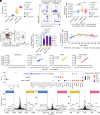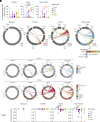Central memory T cells with key TCR repertoires and gene expression profiles dominate influenza CD8+ T cell pools across the human lifespan
- PMID: 40694338
- PMCID: PMC12318230
- DOI: 10.1073/pnas.2501167122
Central memory T cells with key TCR repertoires and gene expression profiles dominate influenza CD8+ T cell pools across the human lifespan
Abstract
Central memory CD8+ T cells (Tcm) represent the prominent memory T cell subset in human blood, yet the persistence of T cell receptor (TCR) clonotypic and transcriptional features of epitope-specific Tcm pools across the human lifespan remains unknown. We analyzed Tcm CD8+ T cells specific for HLA-A*02:01-M158-66 (A2/M158; a prominent influenza epitope) in newborns, children, adults, and older adults directly ex vivo. Our data provide evidence that epitope-specific Tcm CD8+ pools dominate influenza-specific memory A2/M158+CD8+ T cell responses from the early childhood until old age. Tcm gene signatures were largely maintained across the age groups, although self-renewal genes defined Tcm pools in children, while older adult Tcm A2/M158+CD8+ T cells displayed detoxication and stress profiles. TCRαβ diversity within Tcm A2/M158+CD8+ T cell pools was greater in children and older adults, when compared to adults. The key public-associated TCRαβ clonotypes largely persisted across the human lifespan, although their highest frequency was detected in adults, reflecting lower TCRαβ diversity in this group. Older adults displayed increased TCRαβ heterogeneity, underpinned by large TCRαβ clonotype expansions of private TCRαβ clonotypes. Our study highlights the importance of largely preserved virus-specific Tcm pools across the human lifespan and advocates for boosting persistent TCRαβ clonotypes within this key peripheral blood subset.
Keywords: T cell receptors; central memory; human lifespan; influenza-specific T cells; memory T cells.
Conflict of interest statement
Competing interests statement:H.A.M. consults for Ena Respiratory.
Figures




Similar articles
-
Single-Cell Approach to Influenza-Specific CD8+ T Cell Receptor Repertoires Across Different Age Groups, Tissues, and Following Influenza Virus Infection.Front Immunol. 2018 Jun 27;9:1453. doi: 10.3389/fimmu.2018.01453. eCollection 2018. Front Immunol. 2018. PMID: 29997621 Free PMC article.
-
Gradual changes within long-lived influenza virus-specific CD8+ T cells are associated with the loss of public TCR clonotypes in older adults.EBioMedicine. 2025 May;115:105697. doi: 10.1016/j.ebiom.2025.105697. Epub 2025 Apr 17. EBioMedicine. 2025. PMID: 40250246 Free PMC article.
-
Perturbed CD8+ T cell immunity across universal influenza epitopes in the elderly.J Leukoc Biol. 2018 Feb;103(2):321-339. doi: 10.1189/jlb.5MA0517-207R. Epub 2017 Dec 29. J Leukoc Biol. 2018. PMID: 28928269
-
Vaccines for preventing influenza in healthy children.Cochrane Database Syst Rev. 2018 Feb 1;2(2):CD004879. doi: 10.1002/14651858.CD004879.pub5. Cochrane Database Syst Rev. 2018. PMID: 29388195 Free PMC article.
-
Effectiveness and safety of vitamin D in relation to bone health.Evid Rep Technol Assess (Full Rep). 2007 Aug;(158):1-235. Evid Rep Technol Assess (Full Rep). 2007. PMID: 18088161 Free PMC article.
References
-
- Sridhar S., et al. , Cellular immune correlates of protection against symptomatic pandemic influenza. Nat. Med. 19, 1305–1312 (2013). - PubMed
MeSH terms
Substances
Grants and funding
LinkOut - more resources
Full Text Sources
Medical
Research Materials

